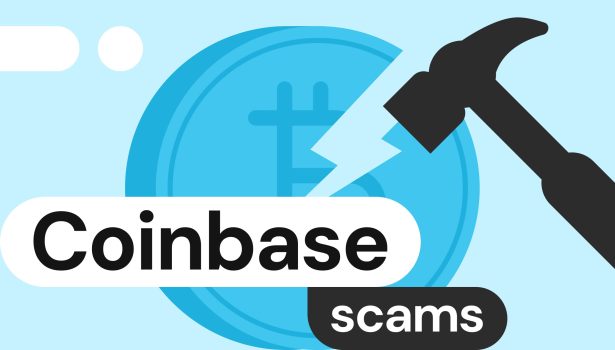Coinbase scam: how to spot, avoid, and respond to fraud

As one of the largest cryptocurrency exchanges in the world, Coinbase is trusted by 65 million investors and traders. The platform’s popularity has increased its visibility and risk for cyberattacks and fraud. Threat actors are sending fake alerts and Coinbase phishing emails to exploit users and steal their sensitive information.
Keep reading this guide as we break down common Coinbase scam tactics, how to identify the red flags, and what you can do to protect yourself.
Common Coinbase scam tactics and how they work
Is Coinbase safe? Absolutely, but threat actors understand that Coinbase is a trusted brand in cryptocurrency, and they exploit that confidence to commit fraud. A Coinbase scam usually imitates the brand’s communication style to convince users to hand over their login credentials or wallet access.
Let’s discuss the most common Coinbase fraud types and how to avoid them.
Coinbase text message scams
Sending fake text messages is a common scam for many types of fraud. In a Coinbase text scam, threat actors may send texts notifying you about suspicious activity on your account. These messages usually include a link that takes you to a fake login page.
Because the attackers created a login page that’s nearly identical to the original, Coinbase users may enter their sensitive information. If you enter your account username and password, the scammers steal your credentials.
How to avoid it: You can avoid a Coinbase text scam by not interacting with any links from sources you don’t recognize. If you need to check your account for issues, log in directly using the official website or mobile app.
Coinbase phishing emails
Phishing emails are another common tactic used by bad to confuse or convince users into thinking the messages are legitimate. To fool victims, criminals borrow tactics from other Crypto wallet scams, such as spam and social engineering, to send emails that mimic Coinbase alerts. Coinbase scam emails may offer promotions or warn users of potential account issues while using the brand’s logos or content layout to make the email look real.
When impersonating technical support, scammers may ask for login information or a verification code. If you share your credentials, criminals can access your wallet and transfer your assets to their crypto wallets.
How to avoid it: Always check the sender’s domain. Legitimate emails come from @coinbase.com—but Coinbase phishing scams often use lookalike domains. If you’re suspicious about an email, contact the platform’s help center directly.
Fake withdrawal notifications
If other tactics don’t work, bad actors may try a Coinbase withdrawal scam. This type of fraud may involve a fake email or a fake Coinbase screenshot showing that a large withdrawal was made from your wallet. The goal is to cause panic so users more likely to click a malicious link without thinking.
Once a Coinbase user clicks the link, it directs them to a fake support line or login page where scammers can steal their sensitive information. Threat actors may also try to send a fake one-time password for a withdrawal.
How to avoid it: Coinbase users can verify any withdrawal by logging into their account through the website, instead of using a questionable link.
Imposter support representatives
Many online scams involve impersonating support staff. In this Coinbase scam, bad actors pose as support agents and reach out to their targets on social media, forums, or through text messages and phishing emails. Scammers try to convince users to share their login information, two-factor authentication codes, or seed phrase.
Threat actors may ask users to download software on their devices or convince them to transfer their crypto assets to a new wallet.
How to avoid it: Coinbase support will never ask for your seed phrase or other sensitive data. It’s best to use Coinbase’s support portal if you need help.
Fake Coinbase apps
As cybercriminals become more sophisticated, they’ve created fake apps that mimic popular mobile apps. Bad actors design a fake app that looks like Coinbase, but its only job is to steal login details from users. You may find these counterfeit apps on unofficial app stores or through malicious links.
How to avoid it: It’s possible to prevent this Coinbase scam by only downloading the app through the Apple App Store or Google Play.
Investment scams
Another type of Coinbase fraud entices users with the promise of “guaranteed returns” if they transfer funds or connect a Coinbase wallet. Bad actors lure their victims in with promotional messages offering a chance to double their cryptocurrency investments in 24 hours. The moment a user sends their cryptocurrency, the threat actor disappears with the money.
How to avoid it: Always remember that legitimate investments never promise guaranteed profits.
How to identify a Coinbase scam
Bad actors try to make their Coinbase scam appear legitimate by any means necessary. This is why knowing how to spot the red flags is important. If you know what to look for, even polished emails, text messages, or fake websites won’t mislead you.
Common red flags of Coinbase scams:
- Urgent or threatening language is a common scare tactic used by criminals to force their targets to give up their information. You may see phrases like “Immediate action required,” or “ Your account will be locked.”
- Grammar and formatting issues are also common in scam messages. These messages often contain spelling mistakes, odd phrasing, and may have formatting issues.
- Mismatched URLs usually have typos or look nearly identical to the official web address. Hover over the link instead of clicking it to see more information and its destination.
- Unverified login prompts come from fake sites that bad actors create to mimic Coinbase’s official webpage.
- Odd requests may come as a Coinbase text message, phishing email, or direct you to log in through a malicious link.
Why does this matter?
Scammers are constantly looking for new ways to exploit Coinbase users. Sometimes, criminals mold their Coinbase scam tactics into something that looks so convincing that it seems identical to legitimate communication. Verification steps are always necessary; access the Coinbase app through the official app or by typing coinbase.com in the browser.
What to do if you’ve been targeted by a Coinbase scam?
Sometimes, being cautious isn’t enough—anyone can be the target of a Coinbase scam. If you’ve clicked a suspicious link, acting quickly can still limit the damage. Here’s what to do:
Report the incident to Coinbase
- Type in the web address for the official support page to report a Coinbase phishing messages and all related activity.
- Email [email protected] to report phishing emails to Coinbase’s support staff. Include the email’s content and full headers so support can conduct a thorough investigation. If the scam was sent via text message, copy and report the text to 7726 (SPAM).
- Cease all contact with the sender.
Secure your Coinbase account
- Secure your account immediately by changing your password. Always use unique, strong passwords that meet the platform’s requirements.
- Enable Coinbase’s multi-factor authentication protocols if you haven’t already. Remember that authenticator apps provide more protection than SMS methods.
- Verify your authenticated devices and log out of any unknown sessions via Coinbase’s account security settings.
Watch for signs and prevent identity theft
If bad actors access your sensitive information, they may try to compromise other online accounts.
- Check your online profiles for suspicious logins, password resets, or unauthorized transactions.
- Consider checking HaveIBeenPwned to see if your information is circulating online.
- If you shared your personal information with scammers, consider freezing your credit or getting a free credit report to prevent financial fraud.
How to protect yourself from Coinbase scams going forward?
Proactive prevention is the best defense against any Coinbase scam, but it isn’t 100% foolproof. No system can prevent all forms of fraud, but practicing good online hygiene helps Coinbase users manage their digital footprint. Here are some proactive steps:
- Always use strong and unique passwords for all online accounts. Password managers are ideal for Coinbase users who want to generate and store their online passwords securely.
- Use multifactor authentication to add an extra layer of security to your investment activities. Authenticator apps, like Google Authenticator or Authy, are solid choices.
- Coinbase users should also consider hardware wallets to store their crypto assets. Hardware wallets keep private keys offline, reducing the chance of theft through phishing or malware.
- Stay informed by reading Coinbase’s scam awareness resources to learn more about protecting your account with security tips.
- Never click links in unsolicited emails, and always double-check communications allegedly from Coinbase. It’s best to go directly to the official website or mobile app for all investment activities.
FAQs
Can Coinbase refund me if I’m scammed?
No, unfortunately, Coinbase doesn’t reimburse funds lost to scams. Since cryptocurrency transactions on the blockchain are untraceable, they are also irreversible. You should report the Coinbase fraud to support and law enforcement, such as the FBI’s IC3.
Can Coinbase freeze my account if I’m scammed?
Yes, Coinbase may restrict or freeze your account if it detects a scam involving your account. This is only meant to protect your funds and doesn’t guarantee the recovery of stolen assets.
What should I do if I clicked a phishing link?
You should immediately change your password, enable multi-factor authentication, and report the incident to Coinbase through their support portal.
Can scammers steal my crypto if they have my email?
No, they can’t. However, they can send you phishing emails to trick you into sharing your password or seed phrase.
How can I check if a Coinbase email is legitimate?
Coinbase emails always come from @coinbase.com addresses. Pay attention to domains with similar spellings or typos to avoid a Coinbase scam. If you’re unsure about an email, log in to the secure app and review your messages.





Mikalai is a Chief Technical Officer at Onerep. With a degree in Computer Science, he headed the developer team that automated the previously manual process of removing personal information from data brokers, making Onerep the industry’s first fully automated tool to bulk-remove unauthorized profiles from the internet.